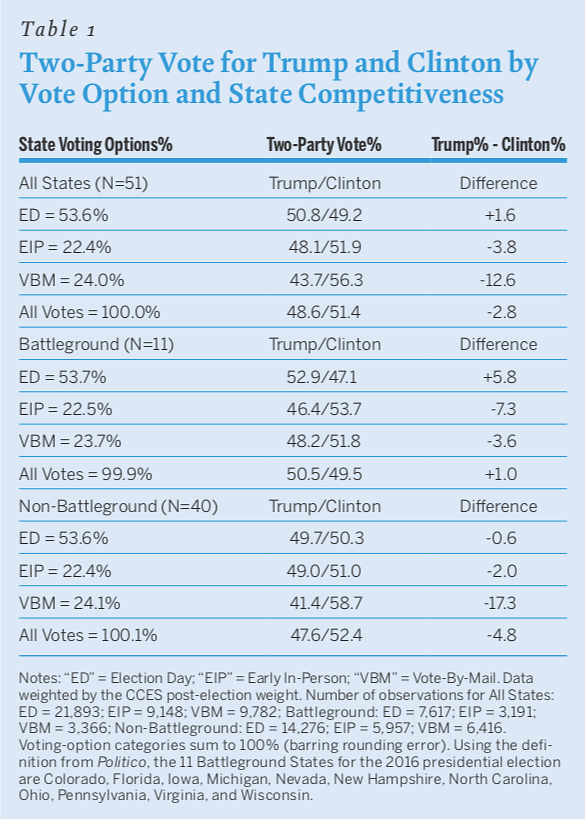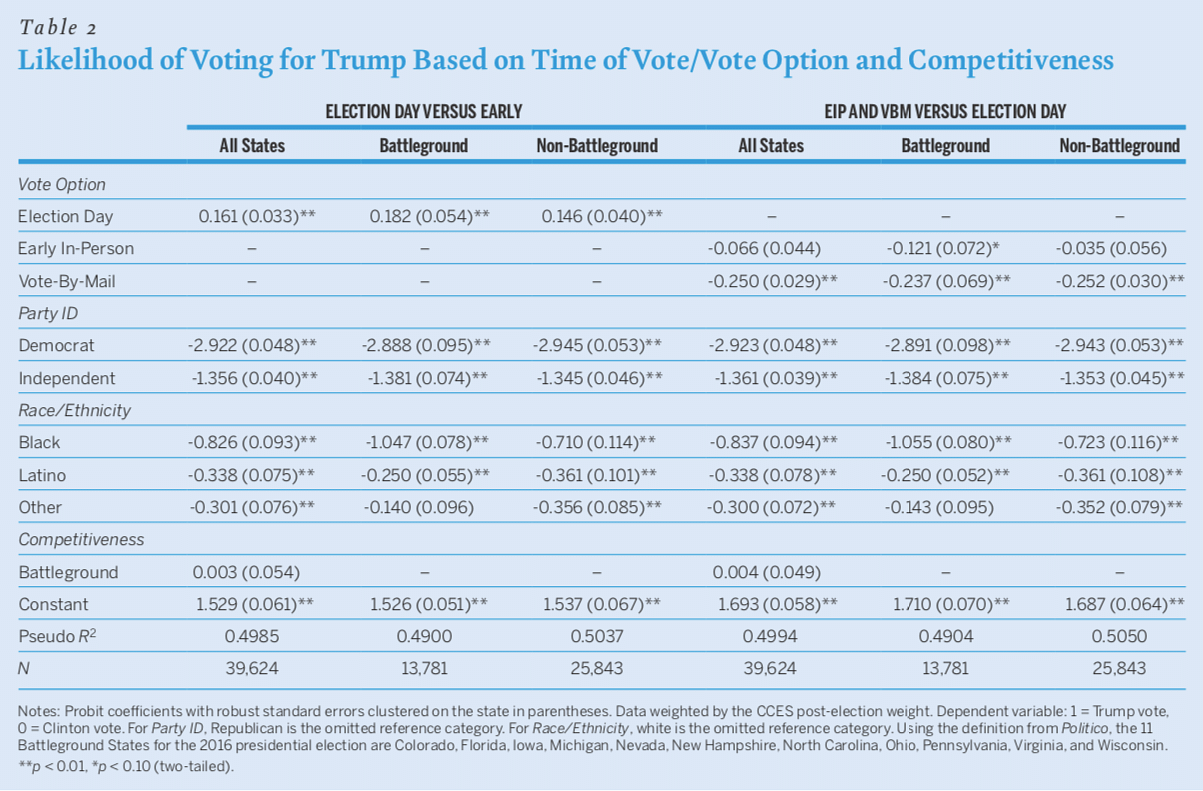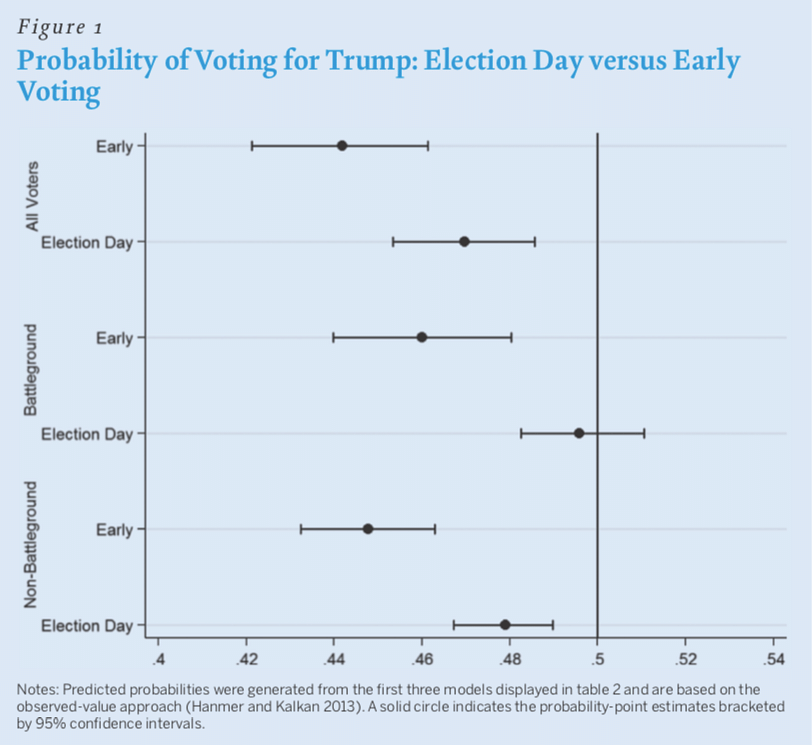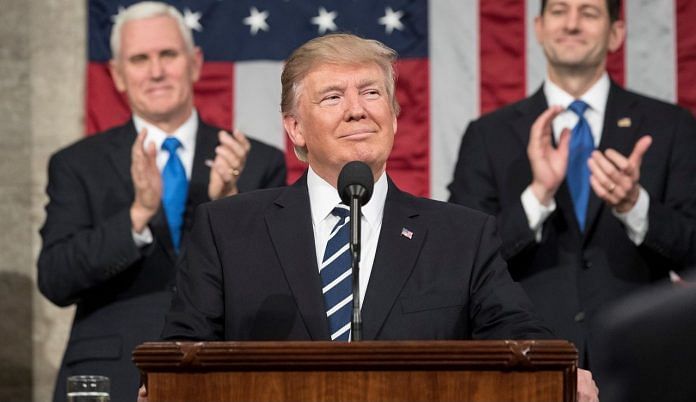The shock victory of Donald Trump still turns heads among the American election forecasters. For them, Hillary Clinton was certain to become the 45th US president. A new study now shows what psephologists missed about the outcome of the 2016 presidential election. Donald Trump was losing — until things flipped on the election day.
Using the 2016 Cooperative Congressional Election Study (CCES) data, the study shows that if not for the notable shift of Election Day (ED) voters to Trump, Clinton would have won.
The shift in support for Donald Trump among ED voters came especially from those residing in battleground states such as Florida, which provide early in-person (EIP) and no-excuse absentee vote-by-mail (VBM) options.
Losing the ‘early’ battle, winning it late
Throughout this study, we relied on CCES respondents’ self-reports of their presidential vote choice and whether their method for casting a vote was EIP, VBM, or ED. Given the wording of CCES’s question for vote method, it was clear that voters who reported voting EIP or VBM did so prior to 8 November 2016. This was critical for our analysis because our fundamental point is that ED voters throughout the nation — particularly in the battleground states that decided the outcome of the 2016 presidential election — were significantly more likely to support Trump vis-à-vis Early voters (i.e., CCES respondents who voted EIP or VBM). We adopted Politico’s definition of presidential battleground states in 2016: Colorado, Florida, Iowa, Michigan, Nevada, New Hampshire, North Carolina, Ohio, Pennsylvania, Virginia, and Wisconsin. These 11 swing states arguably comprise a consensus list, given candidate visits, resource allocation, and media “horserace” coverage of the election.

Our assessment of voting behaviour is sequential. Table 1 displays the portion of voters using ED, EIP, and VBM options and the two-party split in the presidential vote among those CCES respondents in All States (including Washington, DC), Battleground States, and Non-Battleground States. The right-most column in table 1 shows the percentage-point difference in the two-party vote: Trump minus Clinton, for every category of voter (i.e., ED, EIP, VBM, and All Votes).
Starting with All States, Trump won a two-party majority only among ED voters, 50.8 per cent to 49.2 per cent. Clinton prevailed among both types of Early voters, those making use of EIP (51.9 per cent) and VBM (56.3 per cent). Most respondents claimed to vote on Election Day (53.6 per cent) but, of course, Trump is the latest in a small canon of presidents who assumed the office despite garnering a minority of the major-party popular vote. In the Non-Battleground States, Trump was shut out across the board, although he was strongest among ED voters, with 49.7 per cent of the vote.
Also read: Trump is amazing, and science proves it
The most telling finding in table 1 and in the following analyses is the behavior of ED voters in the 11 swing states. Again, Trump fell short among EIP voters, but his 52.9 per cent support among ED Battleground State voters was enough for him to secure a narrow popular-vote victory in the states that decided the winner.
Ultimately, Trump carried seven of the 11 swing states; in the four that he lost to Clinton, he even lost the ED vote (48.8 per cent) — however, he again did best among this group (data not shown). In the seven battleground states that Trump won, he lost the Early vote (i.e., EIP and VBM) but took 53.9 per cent of the ED vote, which comprised 56.8 per cent of this electorate.

Unmistakable signs of election day shift
The evidence that it was ED voters in the key swing states that turned the Electoral College in favor of Trump is unmistakable. First, in the All States model (labeled “All Voters” in the figure, which includes a Battleground States dummy), the probabilities overlap at the 95 per cent confidence interval for ED and Early voters. Second, in the Non-Battleground States model, the probability of voting for Trump is clearly greater for ED voters than Early voters, but Trump still netted less than half of the two-party vote irrespective of voting mode (also true in the probability estimates for All Voters). Finally, only in the Battleground States model did we find that the confidence interval spans 0.50. This is the case only among ED voters, who were significantly more likely to vote for Trump vis-à-vis Early voters (because the confidence intervals do not overlap).
The new ‘Comeback Kid’
In the 1992 Democratic New Hampshire primary, Bill Clinton declared himself the “Comeback Kid” because his second-place finish in a crowded field was a vast improvement over his woeful performance in the Iowa Caucuses. A quarter-century later, his wife seemed almost a certainty to become the 45th president, but her opponent — the political upstart and insurgent amateur Republican, celebrity entertainer, real estate mogul, and erstwhile casino magnate, Donald Trump — became the most surprising “comeback kid” in American history.
Also read: After fiasco in Russia, President Trump’s approval ratings may take a hit
Trump pulled an “inside straight” on Election Day, as voters in battleground states shifted decisively in his favour. Indeed, the 2016 CCES data reveal a remarkable dynamic: in each of the seven swing states that Trump won, he lost the sum of the early vote (i.e., EIP plus VBM). In other words, if not for the marked turn toward Trump on 8 November 2016, in these states, there is no way he would have prevailed.

We leave it to others to dissect whether the “October Surprise” James Comey letter was a sufficient or only a contributing factor to the collapse of the Clinton campaign in the key states that she had to carry. These included the much vaunted “blue wall” trio of Midwestern states (Michigan, Pennsylvania, and Wisconsin) that a Republican managed to scale for the first time since the 1980s.
Furthermore, we are skeptical of the persuasive power of Russian propaganda, but we are certain that 2016 was a “change” election. To this end, Hillary Clinton clearly did not represent something new and different, whereas Trump — the victor, for better or worse — epitomised a historically novel choice. What is palpable from our analysis, however, is that polling the 2016 presidential election proved perilous because the profile of voters in the swing states on Election Day was significantly more pro-Trump than the voters who participated before the last day.
In the pivotal states that would determine the Electoral College winner, past was not prologue in 2016. Many who showed up early—and especially those who mailed in their ballot — were registering their preferences before a topsy-turvy campaign ended with short-term conditions breaking for Trump.
Also read: How US is reacting to former Starbucks CEO’s possible run in presidential elections
Admittedly, there are many questions that remain unanswered with regard to why Trump became one of only a few presidents to take office as a popular-vote loser. Perhaps most obvious, given the thrust of our study, is a more in-depth look at who were those voters that broke late for Trump in the battleground states that he had to win versus those who stayed home or participated earlier in the election cycle. We are certain to have plenty of scholarly company in further assessing the 2016 presidential electorate.
For now, this study is important for an initial examination of the prevailing dynamic of voter preferences in the latest presidential contest, when voting was a drawn-out process so that the early stages of the race did not necessarily reflect and represent the latter stages. At least in the 2016 contest, this meant that Hillary Clinton — the all-but-certain winner — was rendered a shocking loser.
Seth C. McKee is associate professor of political science at Texas Tech University.
Daniel A. Smith is professor of political science at the University of Florida.
M. V. (Trey) Hood III is professor of political science at the University of Georgia.
This article is an edited version of ‘The Comeback Kid: Donald Trump on Election Day in 2016’, originally published by the American Political Science Association, under the Cambridge University Press.




Avoid criticising IAF
We did it we have no reservation and proud of it
Our strength and stamina to bear is enough to prove our heroic acts done by professional
Donot try to squeeze more oil from the dry cakes
Indian Air defence system is obsolete and rusty whereas PAF pilots have carried out combats in recent years, they are well trained and equiped with modern aircrafts. PAF has an edge over their counterpart in the air.
The world should now prepare for the next unthinkable – a second term.